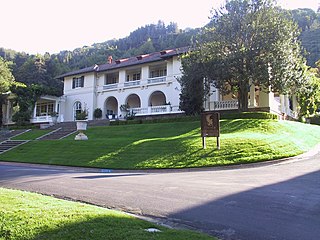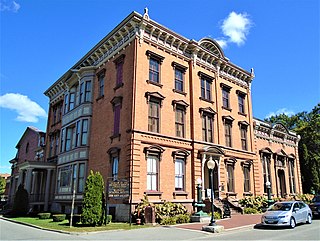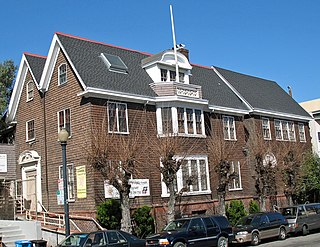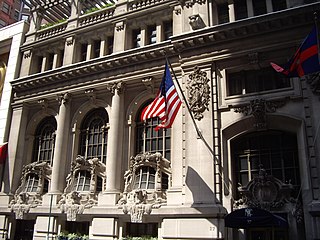
Bernard Ralph Maybeck was an American architect in the Arts and Crafts Movement of the early 20th century. He was an instructor at University of California, Berkeley. Most of his major buildings were in the San Francisco Bay Area.

The Montalvo Arts Center is a non-profit center for the arts in Saratoga, California, United States. Open to the public, Montalvo comprises a cultural and arts center, a park, hiking trails and the historic Villa Montalvo, an Italian Mediterranean Revival mansion nestled in the foothills of the Santa Cruz Mountains. The mansion and estate were constructed from 1912 to 1914 by California statesman and businessman James Duval Phelan. After Phelan's death, the entire estate was donated to California as a park and then a cultural and arts center as it exists today. The arts center maintains the estate in partnership with Santa Clara County. The mansion is a historic landmark, and in 1978 it was awarded inclusion in the National Register of Historic Places.

The Redwood Library and Athenaeum is a subscription library, museum, rare book repository and research center founded in 1747, and located at 50 Bellevue Avenue in Newport, Rhode Island. The building, designed by Peter Harrison and completed in March 1750, was the first purposely built library in the United States, and the oldest neo-Classical building in the country. It has been in continuous use since its opening.

Canfield Casino and Congress Park is a 17-acre (6.9 ha) site in Saratoga Springs, New York, United States. It was formerly the site of the Congress Hotel, a large resort hotel, and the Congress Spring Bottling Plant, as well as Canfield Casino, which together brought Saratoga Springs international fame as a health spa and gambling site. At the peak of its popularity it was a place where the wealthy, major gamblers and stars of the entertainment world mingled. The park's artwork includes a statue by Daniel Chester French and landscape design by Frederick Law Olmsted, among others.

The Players is a clubhouse and theatre located at 3321 East Jefferson Avenue in Detroit, Michigan. It was designated a Michigan State Historic Site in 1985 and listed on the National Register of Historic Places in 1987.

The Sulgrave Club is a private women's club located at 1801 Massachusetts Avenue NW on the east side of Dupont Circle in Washington, D.C. The clubhouse is the former Beaux-Arts mansion on Embassy Row built for Herbert and Martha Blow Wadsworth and designed by noted architect George Cary. During World War I the Wadsworth House was used as the local headquarters for the American Red Cross.

The Girls Club in San Francisco, California, also known as Mission Neighborhood Capp St. Center, was built in 1911 in the Bay Area Tradition version of Shingle Style architecture. It was listed on the National Register of Historic Places in 1979.

The YWCA Building at 1040 Richards Street, Honolulu, Hawaii, popularly called the Richards Street Y, is now officially named Laniākea, which means 'open skies' or 'wide horizons' in the Hawaiian language. It was designed by San Francisco architect Julia Morgan, who considered it one of her favorites. The building consists of two large units which are connected by a two-story loggia. The main building is three stories high and faces Richards St. with a frontage of 165 feet. The second unit, which is directly in the rear of the first, is somewhat smaller, being two stories high with a large basement.

North Star House is a house located roughly a mile south of Grass Valley, Nevada County, northern California. The building served as the superintendent's house for the North Star Mine. Commissioned by Superintendent Arthur De Wint Foote and his wife, Mary Hallock Foote ("Molly"), an author and illustrator, it was designed in 1905 by the architect Julia Morgan. This was her first significant, large-scale, residential project. The house is notable for its relationship to the literary career of Molly Foote and the master architect, Morgan.

The University Club of Albany, New York, was founded at the start of the 20th century. It is currently housed in a Colonial Revival brick building at the corner of Washington Avenue and Dove Street. In 2011 that building was listed on the National Register of Historic Places.

The Dunes Club is a historic private beach club at 137 Boston Neck Road in Narragansett, Rhode Island. The club occupies 28 acres (11 ha) of land fronting Narragansett Bay in central Narragansett, bounded on the north by the Pettaquamscutt River.

The Androscoggin Yacht Club is a private recreational and social club at 22 Lake Street in Wayne, Maine, on the shore of Androscoggin Lake. Founded in 1909, the club provides access to a beach and docks, and has a clubhouse available for the use of its members. The clubhouse was listed on the National Register of Historic Places in 2012, for its architecture and for the role the club played in the development of the region as a summer tourist destination.

The Glendale Woman's Club was first organized in 1901 as a “Self Culture Club”, the primary aim of the Woman’s Club was self-improvement from a literary standpoint. They raised money for the first library and city parks. In 1898 the lumber company moved to a new two-story office building; Mr. Messenger could no longer manage the library. A library association was formed. The women’s club bought up stock and then assigned members to vote. Mrs. May Catlin Hanson, through club member Mrs. Lafe Myers, donated a building which was placed in park to house the library until a new one could be built. Mrs. Robert Clark and Mrs. J.M. (Mary) Pearson took the lead. Mary took a class on “Library work” in Phoenix to be able to “start it out right.”. By 1907, membership had increased to fifty members and it became impossible to continue meeting in homes, so the group began to think of acquiring its own clubhouse. On February 21, 1912, exactly 1 week after Arizona became the 48th state, the Club was recognized 501c3 non profit corporation with 85 members. The Glendale Woman's Club is a member of the General Federation of Women's Clubs.

The Sausalito Woman's Club, at 120 Central Avenue in Sausalito, Marin County, California, was built in 1918. It was designed by Bay Area architect Julia Morgan. It was listed on the National Register of Historic Places in 1993.

The Engineers' Club Building, also known as Bryant Park Place, is a residential building at 32 West 40th Street in the Midtown Manhattan neighborhood of New York City, United States. Located on the southern edge of Bryant Park, it was constructed in 1907 along with the adjoining Engineering Societies' Building. It served as the clubhouse of the Engineers' Club, a social organization formed in 1888. The building was designed by Henry D. Whitfield and Beverly S. King, of the firm Whitfield & King, in the neo-Renaissance style.

The New York Yacht Club Building is a seven-story Beaux-Arts clubhouse at 37 West 44th Street in the Midtown Manhattan neighborhood of New York City. Opened in 1901, the building was designed by architect Whitney Warren of Warren and Wetmore as the sixth clubhouse of the New York Yacht Club (NYYC). The clubhouse is part of Clubhouse Row, a concentration of clubhouses on 44th Street between Fifth and Sixth Avenues. The building is a New York City designated landmark and is listed on the National Register of Historic Places as a National Historic Landmark.
The Ramada House is a 3,800 square-foot residence located in the Catalina Foothills area of Tucson, Arizona. Designed by architect Judith Chafee in 1973, and completed in 1975, the house combines modernist-inspired design with traditional O'odham shade structures to create a unique living space that exemplifies the tenets of critical regionalism. The property was listed on the National Register of Historic Places in 2006.

Saratoga Village Library, formerly known as the Saratoga Library, is a historic building in Saratoga, California designed by architect Eldridge T. Spencer in 1927. The building is historically significant due to its long association with the development of civic life of Saratoga throughout the 20th century, serving as the only library for the community for 51 years. The Saratoga Village Library was placed on the National Register of Historic Places on January 17, 2007. In 1978, the completion of a new Saratoga Library was established on Saratoga Avenue and Fruitvale. The design was also the work of Spencer.

The Wheeler Hospital was a historic hospital constructed in 1929, in Gilroy, California. The hospital was designed by California architect William Henry Weeks and funded by merchant Lin Walker Wheeler. The Wheeler Hospital was placed on the National Register of Historic Places on September 13, 1990. In 1990, the Wheeler Hospital merged with an elder care facility to establish the Wheeler Manor Senior Apartments.

The Willard Griffin House and Carriage House is a historic mansion and carriage house located in Los Altos, California. The estate, constructed in 1901, features a three-story main house designed in the American Craftsman style. The Willard Griffin House and Carriage House was placed on the National Register of Historic Places on April 13, 1977. Today, the house and carriage house are located at the lower section of the of the Foothill College campus.





























